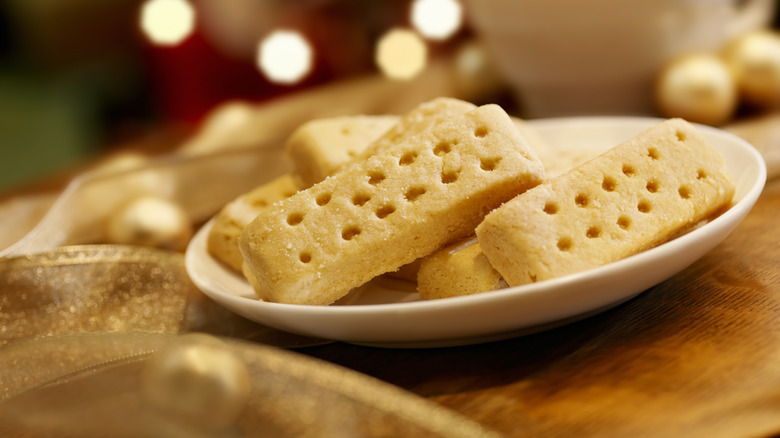This Is How The British Biscuit Got Its Name
It's time to debunk the "cookie vs. biscuit" American-British debate once and for all. For starters, American biscuits are small, fluffy quick breads closer to what the British would call a "scone." In the U.K., what British folks call "biscuits" (delicate, intricate, sweetened or spiced, often with imprinted designs) are closer to what Americans call "cookies." So, how did the British biscuit get its name?
Hop in our culinary time machine. The word "cookie" comes from the Germanic "koekjes" meaning "little cakes." When Dutch settlers first established New Amsterdam at the southern tip of what is now Manhattan Island in 1625, they were all about little cakes. Meanwhile, across the ocean, foodies in the United Kingdom were similarly digging sweet biscuits. Then, in 1674, England seized control of the Manhattan colony. New Amsterdam became New York, and as the Dutch-speaking people gradually transitioned to speaking English, koekjes anglicized to "cookies."
Foodies in the U.K., however, kept the old word — "biscuit" — which traces back to the Old French "bescuit" meaning "twice cooked." Before them, the French got "biscuit" from the Latin "bis coctus," which is also where "biscotti" comes from in Italian. The word "biscuit" has appeared in English in print since the 1300s, but the direct predecessors of English wafers trace back to Medieval biscuits. These would have been a crispy treat made from a sweetened batter that could be rolled or molded into creative shapes and served sweet or savory.
A rose by any name would still smell...like a biscuit
These Medieval proto-biscuits are some of the earliest recorded prepared foods in human history, and basically every culture around the world had some version of a hardened, thin, flour-based wafer. By the 14th century, twice-baked biscuits remained popular in England and were prepared in both sweet and savory styles, and were traditionally eaten after a meal as a digestif.
Over time, a national sweet tooth evolved. In 1641, England established sugarcane plantations in Barbados to domesticate the plant and make sugar a more widely accessible ingredient (with the help of enslaved people). The rising popularity of tea in the 1660s cemented sweetened biscuits' position of culinary dominance for good, and as the English Industrial Revolution emerged in the 1700s, tea and biscuits were a useful way for workers to stay satiated as the main meal of the day moved from lunchtime to the evening.
The sweet English biscuits that many foodies know and love today didn't make their way back to the States until after 1855. These tea snacks found popularity among a raving audience as imported foreign goods, and in 1890, the New York Biscuit Company was formed in Chicago. Fig Newtons, ginger snaps, Animal Crackers, and Nabisco sugar wafers had arrived and were here to stay. Plus, by the time America was officially founded in 1776, biscuits were widely regarded as a pleasure thing, rather than as the utilitarian hardtack of the past.

